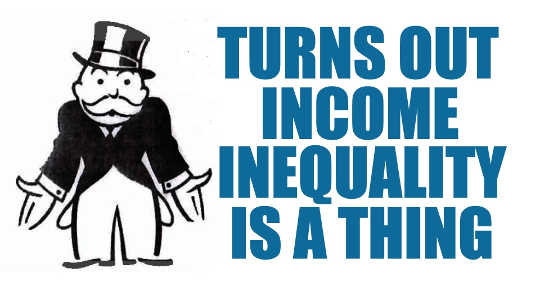
Whether it’s by coincidence or causation, the financial collapse of 2008 and 2009 has resulted in growing angst over income inequality.
Millions of workers disappeared from the workforce and have yet to return. This has magnified the gap between households at one end of the income spectrum and the other.
While this growing concern over the existing income distribution has emerged as a debating point in the worlds of public policy and politics, it’s been a challenge to pinpoint the optimal way to redistribute income to reduce inequality.
Our aim here is not to provide one. Alas, as with beauty and issues of fairness, the optimal distribution lies in the eye of the beholder. Nevertheless, most would agree that reducing the inequality gap is a worthy goal. Understanding what is causing the growing gap between rich and poor is key to figuring out how to reduce it.
Is it driven by natural causes such as age that can’t be easily effected by policy? Or is inequality rooted in more malleable factors like education or tax policy?
A statistical analysis of 53 countries that emerged from a graduate student’s research project provides some clues. And the analysis begins with what social scientists call the Gini coefficient.
Gini in a bottle
The Gini, developed by Italian statistician Corrado Gini in 1912, is a measure of income inequality applicable to both small and large populations, from households to countries.
The Gini coefficient is measured on a scale of zero to one. A Gini of zero indicates that everyone in the defined group shares income equally. This outcome is not necessarily good, however, as everyone in the group could be equally poor or destitute. A Gini of one means that one worker earns all the income and everyone else zero. This outcome is not necessarily bad, as many households depend upon the earnings of a single individual assuming the group is a household.
The Gini Index tracks which societies are the most unequal, and the Central Intelligence Agency lists some of the latest data on its World Factbook. Using just the most recent data on this site, Slovenia ranks as the least unequal with a Gini of 0.24 in 2012, while South Africa suffers from the most inequality, at 0.63 in 2013.
The latest data on the U.S. puts it somewhere in the middle, at 0.41.
‘Natural’ causes of inequality
In an attempt to shed some light on which forces or conditions in the economy affect income inequality, we analyzed how a variety of socioeconomic variables affect the differences between each country’s Gini coefficient.
Initially we looked at how just one variable, age, affected the Gini of 30 countries. We expanded this to 53 relatively developed countries in various continents and 10 variables.
Our analysis showed that the median age of the population appears to have a significant influence on the differences in Gini coefficients, which varies inversely with the median age of the population. That is, older populations are less unequal (have a lower Gini) than younger ones, probably because as individuals age there is less disparity in their incomes. Retirement from productive endeavors is an obvious leveler of income differences. In addition, the incentive to pursue ever-higher incomes diminishes as workers approach retirement, producing the age-earnings curve.
Age is one of the ways income disparity can be attributed to a “natural” cause, thus representing a challenge to policy makers hoping to reduce inequality, and was the most significant variable in our analysis.
Similarly, our analysis shows that greater GDP growth and the percentage of the population employed in the agriculture sector are negatively related to the Gini. That is, countries with higher economic growth or a greater the share of its workers engaged in agriculture have less inequality.
For the most part, the measures identified above can generally be attributed to environmental forces and normal human behavior and are thereby not easily affected by short-term policy. They explain most of the variation among countries in the Gini coefficient. In other words, these findings suggest most inequality is more or less hardwired into our societies and only long-term trends (in policy, demographics, etc.) can affect them.
Where policy can play a role
Our analysis did find that some variables more directly linked to short-term policy choices played a role in explaining the Gini differences among countries.
Among these, the variable that influenced inequality the most was tax policy. In particular, the higher the overall tax rate in terms of revenues as a share of GDP, the lower the Gini. This may help explain why countries like Switzerland and France, which have high tax rates on the wealthy, suffer from less income inequality than the U.S., which has relatively low ones.
But taxation can be a double-edged sword, as taxes may act as a deterrent to productive (income and job creation) behavior. Fortunately, it’s possible to design tax policy that encourages economic growth in the short term while raising government revenue in the long term.
Another policy variable that affects the Gini coefficient is investment. Our analysis showed that increasing investment in productive assets leads to greater income inequality. This seemingly counterintuitive result arises because investment expenditures produce GDP growth at a lag while detracting from current consumption.
The last significant variable we considered is unemployment, which, as you’d expect, leads to more income equality. Although this finding is intuitive (as were our results on aging and growth), it is comforting to learn that statistical analysis confirms what common sense dictates.
Four variables we tested – inflation, years of schooling, GDP per capita and government deficits (as a percent of GDP) – had no measurable influence on income inequality.
Together, these factors explain roughly three-quarters of the differences in the Gini among the 53 countries in our review. In other words, variables we didn’t consider are responsible for a quarter of the deviation in income inequality in these countries. Understanding what those factors are will require further review.
Leveling inequality
Putting these results into perspective suggests that some income inequality emanates from environmental forces and normal human behavior. However, public policy may exert a positive influence on reducing income inequality through economic policy that promotes economic growth, lower unemployment, greater labor force participation and appropriate tax policy.
Although by and large GDP growth is a natural variable that can’t be directly affected by policy makers, it’s still arguably the most important factor in reducing income inequality. Tax and regulatory policy, for example, are indirect ways to influence growth as significant and sustained economic growth has been shown to be among the biggest levelers of income inequality.
We believe public policy would best be structured toward that end.
About The Author
Dale O. Cloninger, Professor Emeritus, Economics & Finance, University of Houston-Clear Lake
This article was originally published on The Conversation. Read the original article.
Related Books
at InnerSelf Market and Amazon
























